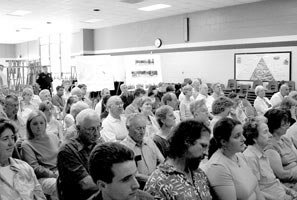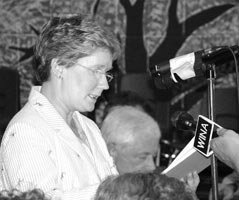Dump dust-up: Citizens gather; Lynch denies role
It was a night many Keswick residents had been waiting for. County officials touted the June 29 meeting at Stone Robinson Elementary as a way to clear the air over a long-simmering controversy. Ever since a January 4 fire choked the skies above Campbell Road and re-ignited debate over the illegal dump operated by Cecil and Doris Gardner, neighbors have demanded answers.
Environmental officials from state and local levels came prepared with answers. But when David Bailey stepped up to the podium and introduced himself as a lawyer retained by several Keswick residents, it was apparent that the questioning had just begun.
County spokesperson Lee Catlin repeated data on a fact sheet mailed to residents. The dump's long life resulted from County error in assuming the site had been "grandfathered" and was thus a legal junkyard, Catlin said. Since citations issued in January ordered the Gardners to clean up the site, 14,298 pounds of rubbish– or 30 percent of the known volume– had been hauled away, Catlin said.
Her speech was followed by updates from officials extolling the inter-agency teamwork of the cleanup. The "coordinated efforts" involve the Department of Environmental Quality (DEQ), County Health Department, zoning administrators, and the Fire Marshall's office.
In the next part of the two-hour meeting, residents could ask questions as long as they confined them to "a sentence or two," Catlin advised. Not an easy task for this topic.
Residents asked if taxpayers would end up footing the bill, whether the County was ultimately accepting responsibility for the cleanup, if buried materials were being addressed, why third-party dumpers haven't been charged, and what testing besides a few wells was under way. People wanted to know if the County would allow a community member to act as an "onsite supervisor," and why, in the face of violations issued over the years, the County claims officials had mistakenly believed the junkyard to be legal until a January reassessment.
The abbreviated questions received pithy answers.
The DEQ's Jed Pascarella said, "We simply don't have any information" on burial sites. He said remediation will rely on what is found as surface materials are removed. Catlin added that the Environmental Protection Agency has not been called in because nothing appears to be leaching into the environment. Responding to health concerns, District Health Director Dr. Susan McLeod said that while the health department has only been involved "for the past month," they have no evidence of elevated cancer rates in the Campbell Road zip code.
In response to questions about allegations from neighbors and relatives of the Gardners that W.A. Lynch Roofing had dumped construction debris, County Zoning Administrator Amelia McCulley said, "The cleanup burden is on the property owners."
Assistant County Attorney Greg Kampter supported McCulley, but offered, "We're open to looking at third party contributors." However, the County has a one-year statute of limitations on third-party solid waste code violators.
Bailey, the lawyer representing neighbors along Campbell Road, noting that the Gardners have owned the property since 1969, said, "This site has been receiving wastes without any permits of any kind– an absolutely unheard of event in this time."
No tests have yet been performed on the site's soil and groundwater, he said, calling for comprehensive testing. County officials are "kidding themselves if they think they can conduct a proper cleanup without the proper assessment," he added.
The lawyer also questioned the County's use of the term "junkyard." Since hazardous wastes have entered the property, Bailey argued, "it must be evaluated and considered a hazardous waste site."
Instead, the County has allowed the site to remain under the control of the original operators, who are using private contractors to remove the wastes and "may be destroying evidence," Bailey said. "The County must seek all responsible parties."
A few days before the meeting, W.A. Lynch Roofing, widely named as a prime contributor to the mess, issued its first statement. In a letter to the Hook (see page 5), company president William A. Lynch Jr. says Lynch is assisting with the cleanup solely to help out Gardner, a longtime employee.
Lynch, who has declined to be interviewed by the Hook, also claims the company inspected the Gardner property recently "and found that only a small percentage of the material is roof-related."
Neighbors, however, suspect that incriminating materials have already been removed. Lynch calls neighbors' eyewitness accounts of "convoys" of his company's trucks entering the Gardners' property full and leaving empty, "simply untrue."
Neighbors stand by their observations.
One meeting attendee, Helen White, blamed residents for the public spotlight on the Gardners. The family is being "made fun of" by the media and "nosy" neighbors, said White, who lives a few miles from the site.
The Gardners did not attend the meeting, which ended with Catlin's declaration, "The voice of the community has been heard tonight."

Many neighbors, but no roofing company reps, spoke at the meeting.
PHOTO BY DEREK PELL

Pat Napoleon, one of the outspoken neighbors, speaks her mind.
PHOTO BY DEREK PELL

The illegal dump was the subject of the Hook 's June 16 cover story.
HOOK COVER
[One of the above photos carried an innacurate identification in the print version of the Hook. It has been corrected in this online edition–editor.]